INTRODUCTION
The rising incidence of diabetes mellitus (DM) is one of the main health issues; the number of diabetic patients is increasing throughout the world, and it is estimated that around 592 million people would have diabetes by 2,035 (Forouhi and Wareham, 2014). DM is a cumulative effect of low insulin secretion, or impaired action of insulin, reduced glucose utilization, and increased glucose production, depending on the type of diabetes. Chronic hyperglycemia is associated with multiple system dysfunction and long-term end-organ damage (American Diabetes Association, 2020).
The microelements are an integral component of glucose homeostasis, antioxidant enzymes, lipid metabolism, and potential pro-oxidant catalysts. In DM patients, complications arise because of responsible factors such as increased oxidative stress, production of free radicals, and protein glycosylation (Makhlough et al., 2015; Mohammed et al., 2018). Copper (Cu) is a pro-oxidant factor; its deficiency leads to glucose intolerance, diminished insulin response, and increased glucose response. Evidence suggests that Cu ions have more affinity to bind protein glycosylation, which causes an oxidative reaction, increased oxidative stress, and free radical production in diabetes (Sarkar et al., 2010). Chromium (Cr) helps in the binding of insulin to cells by increasing the number of insulin receptors and glucose utilization and beta-cell activity. Sufficient dietary intake of Cr reduces the requirement of insulin (Mohamed et al., 2019). Selenium (Se) is another microelement that acts as a cofactor along with glutathione peroxidase, which is an antioxidant enzyme and helps in dropping the formation of free radicals and peroxides of lipoproteins. Lower Se serum levels can be seen in diabetic patients and they increase the risk of hypertension and coronary artery disease (Eva et al., 2017; Wei et al., 2015).
Glycated hemoglobin is essential in the pathogenesis of diabetic vascular complications. The serum concentration of various micronutrients is associated with glycosylated hemoglobin (HbA1c) levels and leads to diabetic complications (Atari-Hajipirloo et al., 2016). However, the assessment of microelements such as Se in diabetic patients remains conflicting with a lot of unanswered questions (Riaz et al., 2014). The present study aims to measure the serum concentration of three microelements (Cu, Cr, and Se) in DM patients. The study also compares the serum concentration of these microelements in diabetic patients and nondiabetic controls. Vague results of studies establishing the association between HbA1c and serum Cu, Cr, and Se concentrations (Atari-Hajipirloo et al., 2016; Unjiati and Adriani, 2015) are found in the literature. Also, we are assessing the correlation of serum Cu, Cr, and Se concentrations with HbA1c levels.
METHODS
Study population
The study was carried out on 252 subjects comprising 126 diabetic patients (Cases) and 126 healthy subjects (nondiabetic) (Controls) matched for age and sex. The age was varied from 35 to 65 years with a median age of 53 years. The team decided to keep 30%–40% of females in each group based on the statistics available about the gender-specific patient distribution at the study site. The sample size was calculated using a specified software for an independent case–control approach based on the proportions representing the group's exposure. This study was performed at Shree Guru Gobind Singh Tricentenary University, Haryana, from September 2013 to August 2018. The subjects and patients were recruited by convenience sampling method based on the availability and willingness to participate. In the control group, healthy individuals from the general population without diabetes or any other comorbidity or complications were taken. Type 2 DM patients with matched age and gender without any other comorbidities were included in the case group.
The exclusion criteria for the case group were pregnant and lactating women, chronic alcoholics, patients taking drugs such as steroids, hormonal, and micronutrient supplements, patients having liver and kidney diseases, and patients with known cases of epilepsy, migraine, or other chronic illness.
After recruiting the patients and healthy subjects as per the inclusion and exclusion criteria, blood samples were collected for specific tests, which are described in the next section.
Ethical consideration
Ethical confirmation was obtained from the Institutional Ethical Committee of Shree Guru Gobind Singh Tricentenary University, Haryana, before the commencement of the study. Currently, the study is being continued with the recently revised ethical approval number IEC/FMHS/F/21/09/18/02. All subjects in this study were recruited after obtaining informed consent and complete history, and a thorough clinical examination was done.
Trace elements and HbA1c analysis
Five milliliters (ml) of venous blood were collected from the antecubital vein using a disposable needle and syringe after overnight fasting for all the cases and controls. The blood sample was centrifuged at 4,000 rpm for 10 minutes, and serum was separated and stored in a deep-freezer at −80°C. Immediately after separating plasma, each sample was diluted with glycerol. Levels of Serum Cu, Cr, and Se were investigated using an auto-analyzer atomic absorption spectrometer. The calibration curve was plotted to know the serum concentration of all metals for each sample.
Glycosylated hemoglobin was analyzed using Immunoturbidity Enhance Enzymatic method and was done in a fully automated analyzer (BS-300).
Statistical analysis
Baseline characteristics were presented as proportions for categorical variables, and continuous variables were presented as mean ± standard deviation. Statistical differences between each parameter of the diabetic and control groups were evaluated for significance by independent T-test and Chi-square test. Concentration differences of serum microelements between diabetic and nondiabetic populations were presented using Box-plots. Scatter-plots are used to present the correlation between serum microelement concentration and HbA1c level. The p-value <0.05 was considered for significant results. The data were analyzed using Statistical Package for the Social Sciences 22.0 statistical analysis software.
RESULTS
Baseline socio-demographic and clinical parameters
The study population included 126 cases and 126 controls in a 1:1 ratio to compare the concentration of microelements. Socio-demographic data and clinical findings of both case and control groups are presented with the significance. Diabetic patients showed a high proportion of dyslipidemia (p < 0.001) than nondiabetics. Baseline laboratory and vital parameters were assessed in both the study groups (Table 1).
Trace elements in diabetic and nondiabetics
The serum concentrations of microelements were compared in both the cases and controls (Table 2). Mean serum Cu concentration was statistically high in diabetic patients than in healthy individuals (p < 0.001) (Fig. 1). The mean serum Cr and Se concentrations were low in diabetic patients than in healthy individuals, and the difference between case and control was statistically significant (p < 0.001) (Figs. 2 and 3).
HbA1c and microelements
We have observed in our study subjects that the serum concentration of Cu increases with the increased levels of HbA1c (Fig. 4). Nondiabetic patients have had normal HbA1c level (<6.5%), and serum Cu concentrations were <120 mcg/dl. Serum Cr concentration proportionally decreases with increased HbA1c level (Fig. 5). The serum concentration of Se was high in patients with normal HbA1c and decreases in patients with chronic abnormal HbA1c level (Fig. 6).
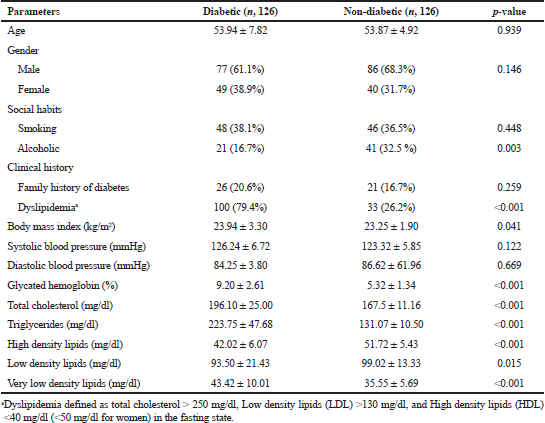 | Table 1. Baseline socio-demographic and clinical characteristics of diabetic and nondiabetic groups. [Click here to view] |
 | Table 2. Comparison of Crchromium, Cucopper, and Seselenium in diabetic and nondiabetic groups. [Click here to view] |
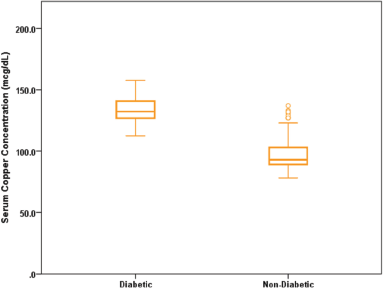 | Figure 1. Box-plot showing the concentration of serum Cucopper in diabetic and nondiabetic individuals. [Click here to view] |
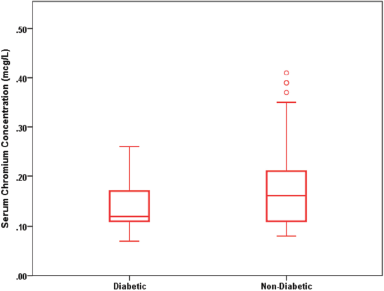 | Figure 2. Box-plot showing the concentration of serum Crchromium in diabetic and nondiabetic individuals. [Click here to view] |
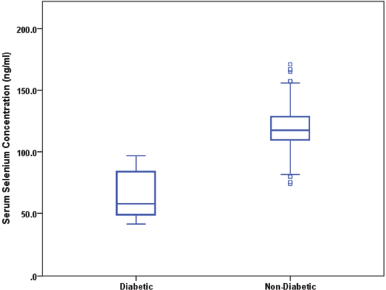 | Figure 3. Box-plot showing the concentration of serum Seselenium in diabetic and nondiabetic individuals. [Click here to view] |
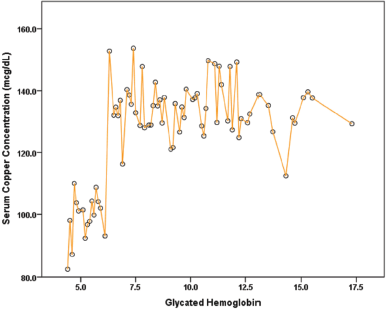 | Figure 4. Scattered plot showing the correlation between serum Cucopper concentration and glycated hemoglobin. [Click here to view] |
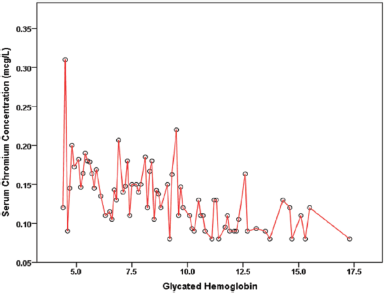 | Figure 5. Scattered plot showing the correlation between serum Crchromium concentration and glycated hemoglobin. [Click here to view] |
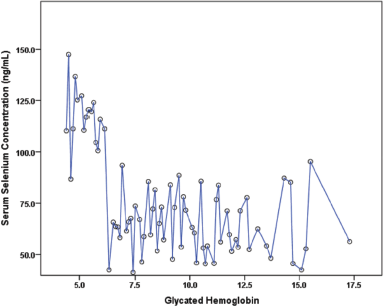 | Figure 6. Scattered plot showing the correlation between serum Seselenium concentration and glycated hemoglobin. [Click here to view] |
DISCUSSION
In the present study, we have observed a higher level of serum Cu and lower levels of serum Cr and Se in diabetic patients compared with the control subjects. Our observations also demonstrated a significant difference in the serum concentration of the studied microelements in both diabetic and healthy subjects. We also correlated the serum concentration of the microelements with HbA1c in all participants. The significant distribution differences were noted in serum levels of Cu, Cr, and Se in patients with normal and high HbA1c levels.
Macro and microelements play a major role in the growth and metabolism and are also involved in the development of secondary complications of DM (Mahdizadeh et al., 2014). Various studies have reported that the change in concentration of microelements might be a contributing factor in the pathogenesis of diabetes. The imbalance in the metabolism of some microelements adversely affects pancreatic islet and causes diabetes. Furthermore, microelements imbalance increased the generation of some reactive oxygen species (ROS) and hyperglycemia causes oxidative stress (Abou-Seif and Youssef, 2004). Earlier studies showed the involvement of Cu, causing oxidative stress (Saha-Roy et al., 2014).
Furthermore, generate ROS and free radicals by active participation in Heiber-–Weiss and Fenton reactions. In diabetic patients, Cu is involved in glycation and its stimulation and causes the release of Cu ions from Cu-binding sites. These Cu ions release into the blood and enhance glycation for end products (Babalola et al., 2007). These glycation end products play a role in the pathogenesis and progression of diabetic complications. In this study, we have analyzed that the serum concentration of Cu was significantly higher in diabetic patients than in healthy individuals. Studies evaluating serum zinc and Cu levels in DM patients showed higher Cu levels in diabetic patients (with and without complications) than the controls (Devi et al., 2016; Nagarajrao and Alharbi, 2015; Zargar et al., 1998).
Cr is an essential microelement and possesses anti-diabetic effect. It helps in improving fasting blood sugar, insulin function, and insulin-receptor binding properties. Cr causes pancreas beta-cell sensitivity and glucagon action (Mohamed et al., 2019). It acts by enhancing the effect of insulin by increasing the number of insulin receptors and binding (Rafi and Narayana, 2019). Our observations showed a low serum concentration of Cr in diabetic patients (p < 0.001) than in healthy subjects. A prior study showed the association of Cr levels and glycemic control and reported that mean serum Cr concentration was significantly lower (p < 0.05) in uncontrolled type 2 diabetic patients (Rajendran et al., 2015). Another study compared the levels of plasma Cr and urine Cr in non-insulin-dependent DM patients and found that plasma Cr was lower by 33% and urine Cr higher by 100% in their patients. The investigator showed that plasma Cr was inversely correlated with plasma glucose during the onset of diabetes (Sutiari et al., 2017).
The present study showed significantly low serum Se concentration in diabetic patients than in healthy subjects (p < 0.001). The third National Health and Nutrition Examination Survey (NHANES III) and NHANES 2003–2004 both showed a positive correlation between serum Se and the prevalence of diabetes (Laclaustra et al., 2009). Serum Se levels in uncomplicated DM patients showed similar results (Riaz et al., 2014). Another investigator evaluated the correlation of dietary Se with diabetes in middle-aged and older Chinese adults and showed that the average dietary Se intake level is 43.51 μg/days among middle-aged and elderly adults. There was a significant positive association between dietary Se intake and serum levels in diabetic patients (p = 0.03) (Wei et al., 2015).
In the present study, we have observed a significant positive correlation between serum Cu and HbA1c in both diabetic and healthy subjects. In contrast, serum Cr and Se decreased with an increase in HbA1c in diabetic patients than healthy individuals. A study analyzed the association between HbA1c and levels of microelements in DM patients and control subjects. The investigator observed that HbA1c levels were positively correlated with Cu in patients with DM (p < 0.05) (Atari-Hajipirloo et al., 2016). Some researchers have reported their hypothesis that binding of transition metals (CU and Fe) with glycated proteins may result in glycocholate formation (Naka et al., 2013). Other than this, it is known that at a high glucose concentration, Cu ion is released, zinc-superoxide dismutase, which may explain the mechanism of how serum Cu level increased under diabetic conditions (Viktorínová et al., 2009). Cr has shown an inverse linear correlation with the HbA1c level (Rajendran et al., 2015; Unjiati and Adriani, 2015). However, the association of microelements with HbA1c should be evaluated to understand the exact mechanisms better.
Strengths of the study
The study compares the serum concentrations of trace elements between healthy controls and patients with DM and establishes an association of these concentrations with HbA1c level. Based on the HbA1c level, clinicians can predict micronutrient deficiencies and related complications in diabetic patients and vice versa. The study also included the participant with matched characteristics (age and gender ratio) in both groups. One of the major significance of this study was its exclusion criteria. We have excluded all the patients or healthy subjects with any other comorbidity to avoid the confounders and getting the relevant results. This is also one of the rare studies that assessed the correlation between Se serum concentration and HbA1c level.
Limitations of the study
Micronutrient deficiency and serum concentration are associated with dietary alterations in both healthy subjects and DM patients. This study did not measure the dietary consumption of trace elements in any study group, so it could not establish any relationship between serum concentrations and HbA1c level.
CONCLUSION
The study demonstrated the significant difference between serum concentrations of all three microelements (Cu, Cr, and Se) among diabetic patients and control subjects. The difference in Cu and Cr levels between cases and controls may play a crucial role in the pathogenesis of this disease as these metals involve in the oxidative stress response. The study also observed that increased levels of Cu and decreased levels of Cr and Se were associated with the increased value of HbA1c in diabetic patients. Further studies to find an association and to avoid/delay the complications by dietary alterations of microelements in diabetic patients are recommended.
ACKNOWLEDGMENTS
The authors want to thank the laboratory facilities of King George’s Medical University, Lucknow, Uttar Pradesh, for their support in analyzing trace elements.
Author’s contribution
All the authors are eligible to be an author as per the international committee of medical journal editors (ICMJE) requirements/guidelines.
CONFLICT OF INTEREST
The authors do not declare any conflict of interest.
FUNDING
The study did not get any external funding.
ETHICAL APPROVALS
The study is being continued with the recently revised ethical approval number IEC/FMHS/F/21/09/18/02.
PUBLISHER’S NOTE
This journal remains neutral with regard to jurisdictional claims in published institutional affiliation.
REFERENCES
Abou-Seif MA, Youssef AA. Evaluation of some biochemical changes in diabetic patients. Clin Chim Acta, 2004; 346(2):161–70. CrossRef
American Diabetes Association. Classification and diagnosis of diabetes: standards of medical care in diabetes—2020. Diabetes Care, 2020; 43(S1):S14–31. CrossRef
Atari-Hajipirloo S, Valizadeh N, Khadem-Ansari MH, Rasmi Y, Kheradmand F. Altered concentrations of copper, zinc, and iron are associated with increased levels of glycated hemoglobin in patients with type 2 diabetes mellitus and their first-degree relatives. Int J Endocrinol Metab, 2016; 14(2):1–7. CrossRef
Babalola OO, Ojo LO, Akinleye AO. Status of the levels of lead and selected trace elements in type 2 diabetes mellitus patients in Abeokuta, Nigeria. Afr J Biochem Res, 2007; 1(7):127–31.
Devi TR, Hijam D, Dubey A, Debnath S, Oinam P, Devi NT, Singh WG. Study of serum zinc and copper levels in type 2 diabetes mellitus. Int J Contemp Med Res, 2016; 3(4):1036–40.
Eva H, Akhter QS, Alam MK, Ahmed S. Serum chromium and selenium levels in type 2 diabetes mellitus. J Bangladesh Soc Physiol, 2017; 12(2):72–5. CrossRef
Forouhi NG, Wareham NJ. Epidemiology of diabetes. Medicine (Abingdon), 2014; 42(12):698–702. CrossRef
Laclaustra M, Navas-Acien A, Stranges S, Ordovas JM, Guallar E. Serum selenium concentrations and diabetes in US adults: national health and nutrition examination survey (NHANES) 2003–2004. Environ Health Perspect, 2009; 117(9):1409–13. CrossRef
Mahdizadeh R, Shirali S, Ebadi P. Investigation of imbalance of trace elements in patients with type 2 diabetes mellitus. J Acad Appl Stud, 2014; 4(9):11–21.
Makhlough A, Makhlough M, Shokrzadeh M, Mohammadian M, Sedighi O, Faghihan M. Comparing the levels of trace elements in patients with diabetic nephropathy and healthy individuals. Nephrourol Mon, 2015; 7(4):e28576. CrossRef
Mohamed HM, Sadik IM, Eltom A, Osman AL, Babker AM. A study of correlation of serum chromium level with glycosylated haemoglobin (HbA1c), total cholesterol and triglycerides, among type 2 diabetes patients. Open J Blood Dis, 2019; 9(1):1–8. CrossRef
Mohammed RR, Mehrez MM, Abdel-Maksoud H. Biochemical relations between copper, selenium, zinc, and magnesium with the glycemic state of diabetic pregnant women. Benha Med J, 2018; 35(3):344. CrossRef
Nagarajrao R, Alharbi SA. Evaluation of serum zinc, copper, magnesium and iron levels in type 2 diabetes mellitus patients. Int J Adv Res, 2015; 3(2):960–5.
Naka T, Kaneto H, Katakami N, Matsuoka TA, Harada A, Yamasaki Y, Matsuhisa M, Shimomura I. Association of serum copper levels and glycemic control in patients with type 2 diabetes. Endocr J, 2013; 60(3):393–6. CrossRef
Rafi M, Narayana SL. A study of chromium levels in type 2 diabetes mellitus. Int J Med Health Res, 2019; 5(6):126–30.
Rajendran K, Manikandan S, Nair LD, Karuthodiyil R, Vijayarajan N, Gnanasekar R, Kapil VV, Mohamed AS. Serum chromium levels in type 2 diabetic patients and its association with glycaemic control. J Clin Diagn Res, 2015; 9(11):OC05. CrossRef
Riaz M, Mahmood KT, Irfan K. Serum levels of selenium in uncomplicated type-2 diabetic patients and healthy individuals. Int J Pharm Sci Res, 2014; 5(10):4219.
Saha-Roy S, Pal S, Bera S, Choudhury KM, Bhattacharya A, Sen G, Gupta S. Status of serum magnesium, zinc & copper in patients suffering from type-2 diabetes mellitus. J Drug Deliv Ther, 2014; 4(1):70–2. CrossRef
Sarkar A, Dash S, Barik BK, Muttigi MS, Kedage V, Shetty JK, Prakash M. Copper and ceruloplasmin levels in relation to total thiols and GST in type 2 diabetes mellitus patients. Indian J Clin Biochem, 2010; 25(1):74–6. CrossRef
Sutiari NK, Rimbawan R, Kusharto CM, Purwatyastuti, Effendi AT. Glycated hemoglobin (Hba1c), blood glucose, and chromium levels among type 2 diabetic patients: a cross-sectional study in Denpasar, Bali. Int J Sci Basic Appl Res, 2017; 2(36):135–44. CrossRef
Unjiati WB, Adriani M. Chromium and zinc level of patients with type 2 diabetes and non-diabetes. Biochem Physiol, 2015; 5:2. CrossRef
Viktorínová A, Tošerová E, Križko M, ÄŽuraÄková Z. Altered metabolism of copper, zinc, and magnesium is associated with increased levels of glycated hemoglobin in patients with diabetes mellitus. Metabolism, 2009; 58(10):1477–82. CrossRef
Wei J, Zeng C, Gong QY, Yang HB, Li XX, Lei GH, Yang TB. The association between dietary selenium intake and diabetes: a cross-sectional study among middle-aged and older adults. Nutr J, 2015; 14(1):18. CrossRef
Zargar AH, Shah NA, Masoodi SR, Laway BA, Dar FA, Khan AR, Sofi FA, Wani AI. Copper, zinc, and magnesium levels in non-insulin dependent diabetes mellitus. Postgrad Med J, 1998; 74(877):665–8. CrossRef